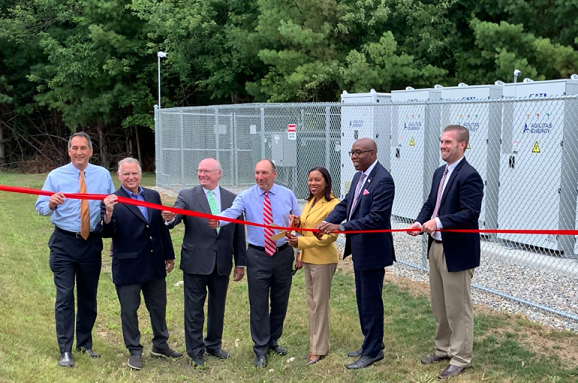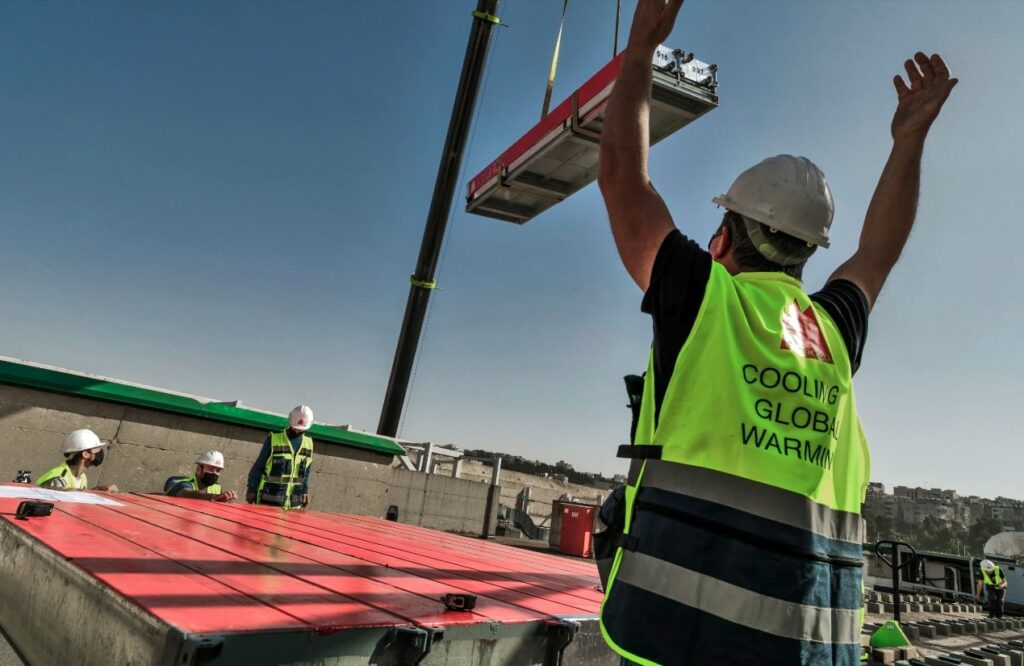Ribbon-cutting last August for the 3MW/9MWh in Rhode Island. Image: Agilitas Energy.
Agilitas Energy, a developer of distributed solar PV and energy storage with a focus on the north-east US, is our latest respondent in Energy-Storage.news’ Q&As on the year just gone.
The company’s assets participate in renewable energy policy-driven markets such as the Solar Massachusetts Renewable Target (SMART) programme and across the New England ISO region’s wholesale markets.
That includes, for example, the first utility-scale battery energy storage system (BESS) in the state of Rhode Island, a 3MW/9MWh system which Agilitas brought online last year. The company develops, builds, owns and operates its renewable energy and battery assets, managing their end-to-end lifecycle.
The US energy storage market is continuously evolving, and its already pretty healthy growth rate is expected to accelerate off the back of the Inflation Reduction Act (IRA).
It will be interesting to see what sort of role more distributed grid-scale, community energy and commercial and industrial (C&I) systems of the type the company is involved with will play, versus the much larger systems you might typically see covered on Energy-Storage.news more often.
We hear from Agilitas’ president and board member Barrett Bilotta on what the company saw play out in 2022 and might expect during 2023.
What did 2022 mean for your energy storage business, and how did the year compare with 2021?
This year was a breakthrough year for our company. In 2022, Agilitas Energy received a $350 million equity investment from funds managed by CarVal Investors to accelerate the development, construction and operation of more than one gigawatt of distributed and utility-scale energy storage and solar PV projects that we have in our pipeline.
Other highlights from the past year include bringing Rhode Island’s first ever utility-scale energy storage project in Pascoag, RI to commercial operation and beginning construction on our first Vermont-based project.
We also completed construction on a coupled solar and storage project in Rochester, MA that will help power more than 1,800 homes annually. We expect that, in 2023 when it reaches the final stage of commercial operation, the 13.4MWh of storage capacity of this project will not only increase the total output of the array, but also provide peak shaving capabilities to stabilise the grid’s power supply.
We’re constructing or actively developing several similar projects throughout the Northeast, too, and are looking to forward to building on this momentum and expanding into additional markets in the coming year. Beyond projects, we nearly doubled our headcount in 2022 as we added new functions to the company.
What were some of the biggest gains and steps forward made by the industry, including your company, during the last 12 months?
In addition to the obvious advantages from the IRA, one of the biggest trends was our industry finally realising the potential of pairing storage with renewable energy.
It seems straightforward, but for years we’ve been building standalone solar or standalone storage projects. On their own, they’re great – and we do need more of that type of development – but together they help boost grid reliability and take pressure off utilities during times of peak demand.
For example, our company completed construction in June of a 7.3MW solar PV, 9.5MWh battery storage system in Auburn, MA. The project is classified as a community solar project under the state’s Solar Massachusetts Renewable Target (SMART) programme.
To date, it is one of the largest projects we have managed, and it will give local consumers the benefit of lower-cost electricity and power more than 1,200 Massachusetts homes annually. With its essential storage component, this project will help take stress off the local grid at times of peak demand and because easing demand pressures significantly impact rates, it will save taxpayers money, too.
Agilitas solar-plus-storage project in Massachusetts, which also reached commercial operation in 2022. Image: Agilitas Energy.
The industry faced some well-documented challenges during the year, with the highest profile being supply chain constraints. How have those challenges affected the industry and how should they be confronted?
Looking across the market, it’s clear that supply chain constraints are one of, if not the biggest, challenges facing our industry.
With battery cell prices soaring and tariffs remaining an ongoing obstacle to navigate, our collective ability to add renewable capacity is severely limited. While these challenges can be frustrating, it opens an opportunity for proficient developers who have capabilities across the entire lifecycle of a project.
With that insight, you can better plan and better adapt to challenges. Our team has had success with strategic inventory management by leveraging buffer stocks and increasing the amount of collaboration between our internal design and engineering, procurement and construction (EPC) teams. While we hope things will settle in 2023, we’re preparing for whatever challenges might come our way.
Which technology and industry trends would you recommend our readers keep a close eye on in 2023?
In 2023, energy storage capacity will be an important topic to keep an eye on. As I mentioned earlier, I think we’ll see more developers actively looking to couple their renewable projects with batteries.
One unique approach we take at Agilitas Energy is leveraging our proprietary bidding and forecasting model called Intelligent Power Dispatch. This model helps us optimise revenue by predicting market conditions in day-ahead and real-time energy markets. This easy-to-use, yet powerful, model gathers real-time and forecasted data from the electricity grid, weather stations, forward curves and energy assets to generate a revenue optimised dispatch schedule.
It’s a critical tool that helps us be as effective as possible when adding energy storage capacity to the grid.
Another important issue will be the ongoing challenges posed by the interconnection queue. According to Lawrence Berkeley National Laboratory’s latest report on US interconnection queues, only 13% of solar, wind and energy storage projects in approval queues have signed interconnection agreements.
Moreover, in the past decade, only about 23% of all projects in interconnection queues have successfully connected to the grid and begun operating.
To avoid this potential roadblock and decrease the associated costs, utilities and developers must work together. One way to do so is by identifying slight site design changes. It is also imperative that policy is passed incentivising interconnection.
Two great examples of what the industry can – and should be doing – to promote energy storage and overcome these challenges are the SMART programme and Clean Peak Energy Standard in Massachusetts, because they are able to provide revenue certainty to renewable and energy storage developers.
What are the biggest priorities for your company, and for the wider industry, in 2023 and beyond?
Looking toward 2023 for Agilitas Energy, we expect to leverage the benefits afforded by the IRA and continue executing using our recent financing to successfully connect renewables and storage projects to the grid.
We’re also focused on expanding into new markets across the country, building on the leadership position we’ve built in the Northeast. Similar to the rest of the industry, we have lots of momentum propelling us forward.
Now, it’s all about rolling up our sleeves and getting to work.
Energy-Storage.news’ publisher Solar Media will host the 5th Energy Storage Summit USA, 28-29 March 2023 in Austin, Texas. Featuring a packed programme of panels, presentations and fireside chats from industry leaders focusing on accelerating the market for energy storage across the country. For more information, go to the website.
Continue reading










